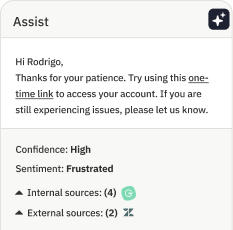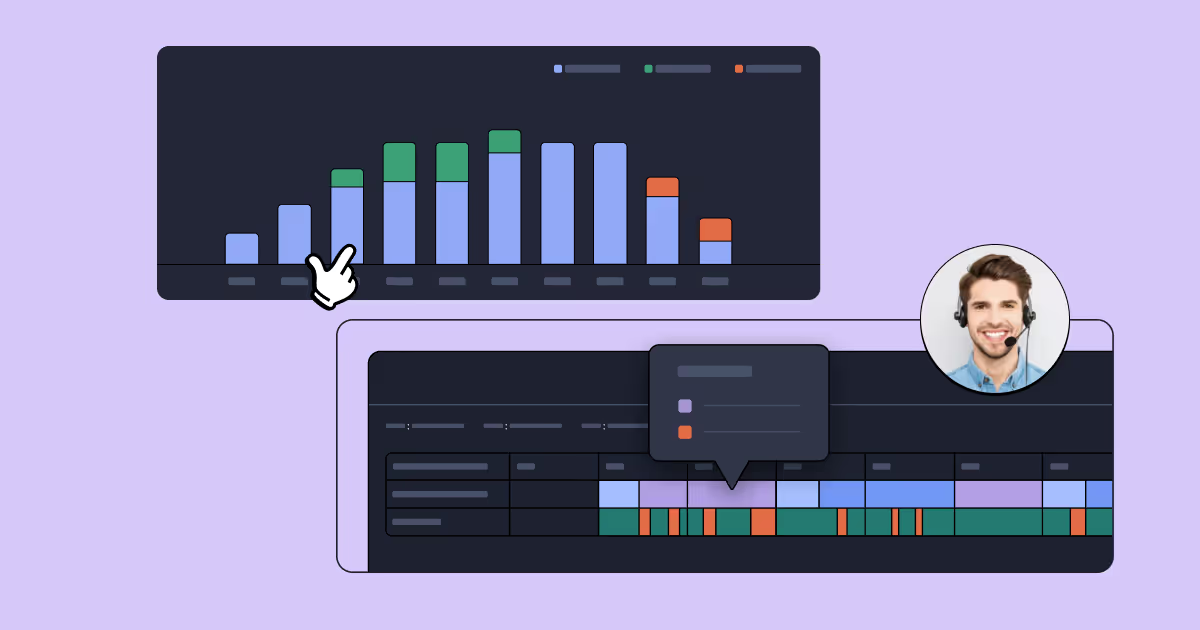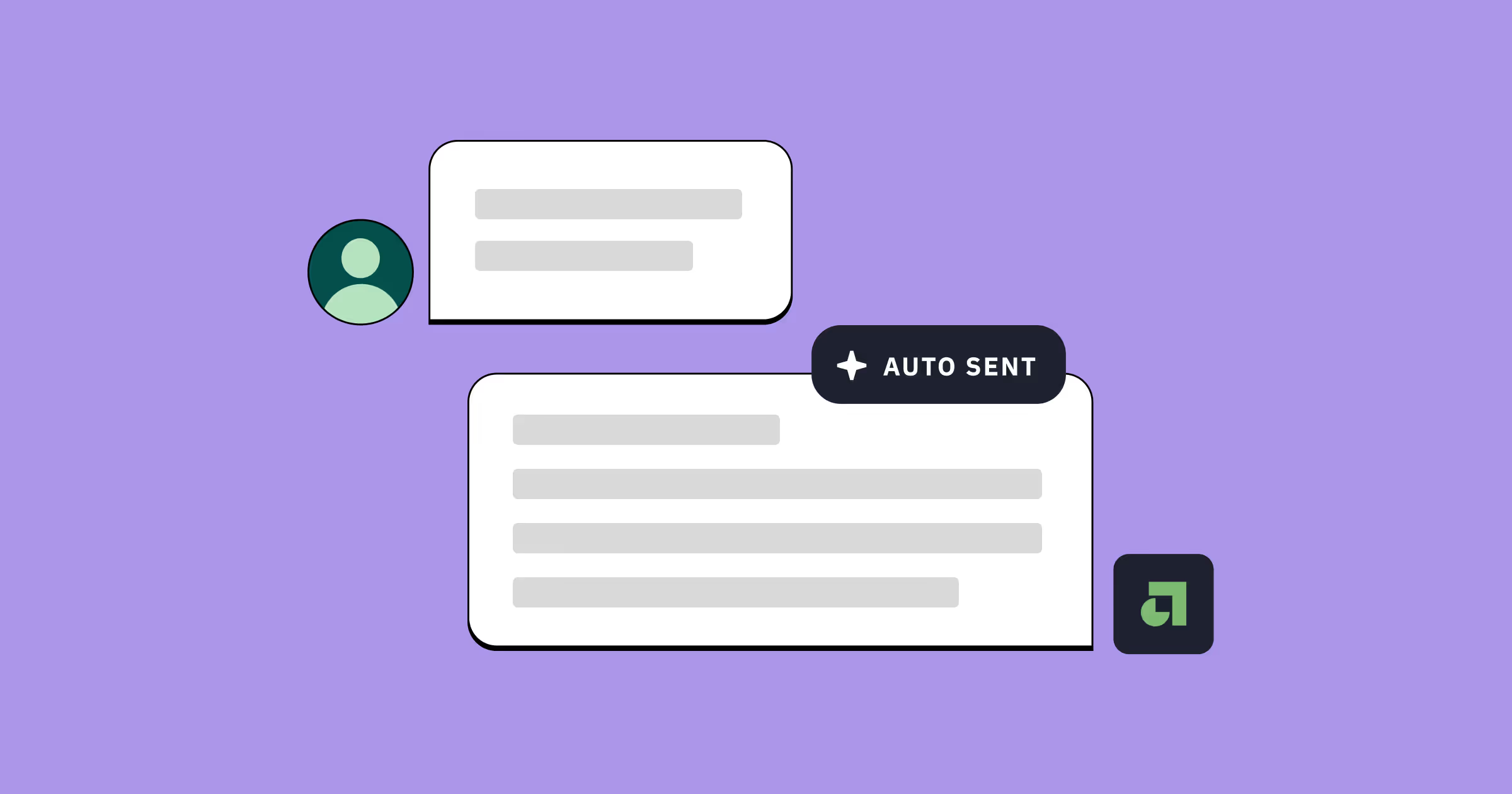10 contact center automation trends to follow in 2025
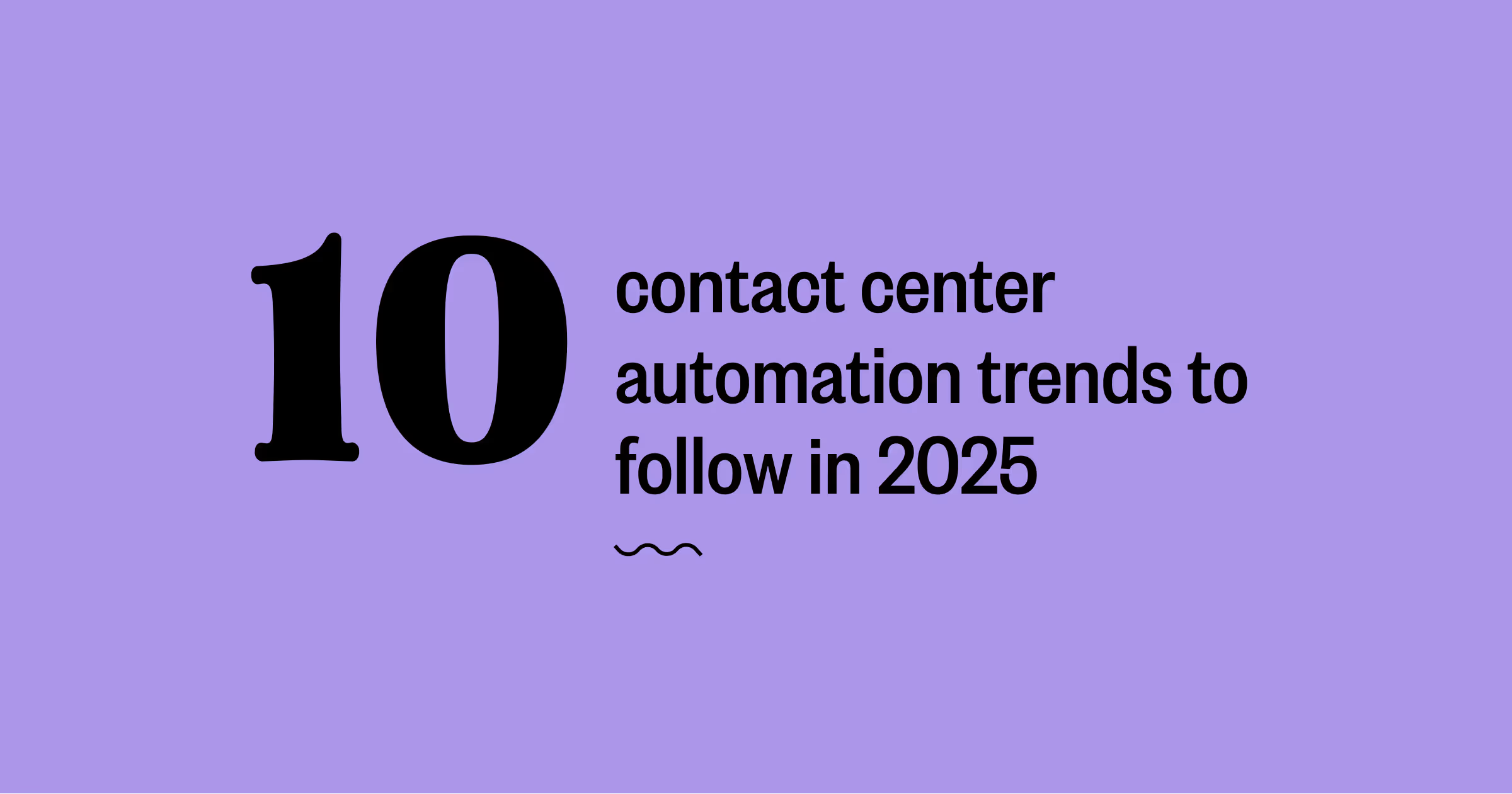
Unless you’ve been living under a rock (and honestly, even if you have been), you’ve heard plenty about automation and artificial intelligence. Much of that hype is well-deserved — AI and automation tools can help your call center streamline workflows, offload repetitive or time-consuming tasks, and even improve your customer experience.
But, with so much buzz around AI-powered solutions, it’s tough to cut through the noise and understand exactly how to use automation technology to level up your customer support.
Fortunately, taking a look at contact center automation trends can help you understand how other teams are using AI as part of their contact center operations. Those use cases can be your inspiration as you implement (or make better use of) this technology to exceed customer expectations and boost your operational efficiency.
What is contact center automation (and why is it important)?
Before we get into what’s up and coming in the world of automation solutions, it’s helpful to have a basic understanding of exactly what contact center automation is.
Put simply, it’s when you automate tasks and processes within your contact center – meaning that they’re handled partly (or entirely) by automation solutions, with little to no involvement from your human agents.
Automation can take shape in a variety of ways on your support team, such as:
- Chatbots that automatically respond to customer queries
- Call routing that directs customers to the agent or department that’s the best fit for their specific needs
- Predictive analytics to anticipate customer needs and proactively offer solutions
- Agent assist tools that pre-draft responses, suggest relevant knowledge base articles, or provide helpful hints in real-time
- Automated transcription and sentiment analysis to evaluate customer interactions as they happen
- Workflow automation to trigger follow-up actions, ticket escalations, or resolutions
- SLA monitoring to automatically alert managers when service levels are at risk
All of those are examples of contact center automation — and that’s only a small slice of what’s possible. With so many applications, it makes sense that automation and AI tools are rapidly growing in customer support.
In HubSpot’s survey of customer service professionals, 84% of respondents say automation tools will be instrumental in helping them meet customer expectations. And, according to a recent Deloitte survey, process automation is a top priority among CX leaders.
Wondering why so many support leaders are jumping on the AI and automation bandwagon? Well, when used intentionally and strategically, these automated contact center solutions can be undeniably effective. They can help support teams:
- Reduce customer wait times
- Improve first response times and resolution times
- Boost customer satisfaction and loyalty
- Decrease customer churn and improve agent retention
- Increase agent productivity
- Optimize staffing and scheduling efficiency
- Lower operational costs
That’s not to say AI is a magic bullet. It’s a tool — not a total fix. But, when leaders are mindful of their needs and sticking points so they can roll out functionality that specifically addresses those, that’s when they reap the benefits of this technology without sacrificing their customer engagement or the experience of their contact center agents.
10 contact center automation trends for 2025
Even if you’re convinced of the benefits of AI-driven solutions, the whole thing still feels challenging to keep up with. Tools, algorithms, and best practices (not to mention customer behavior) are constantly changing, so it’s easy to feel like you’re chasing your tail.
That doesn’t mean it’s time to throw up your hands. 86% of companies admit that outdated technology and inflexible systems hinder their ability to respond to customer needs, so now is the time to embrace change — not ignore it.
Here’s the good news: we’re here to help. We’ve pulled together 10 of the most notable contact center automation trends so you can get (and hopefully, stay) ahead of the curve.
1. Robotic process automation
What it is: Robotic process automation (RPA) uses software robots (i.e. bots) to handle rule-based, repetitive tasks without human intervention. These bots can interact with different systems your contact center uses, process data (like customer and historical data), and complete workflows quickly and accurately.
What it’s used for:
- Automating data entry and retrieval across platforms
- Updating CRM records following customer interactions
- Routing calls and tickets based on customer data and intent
- Sending follow-up emails or surveys without agent involvement
- Processing refunds or addressing other routine customer inquiries
Example: Your contact center uses RPA to instantly and automatically update your customer records after a call, recording all of the relevant details without any additional manual work from a human agent.
Why it matters: By eliminating time-consuming routine tasks, RPA reduces errors, makes your support team more efficient, and gives your agents more time and energy to focus on high-value interactions that require more of a human touch. AI and RPA solutions are expected to reduce the amount of time agents spend on repetitive processes by up to 40% by 2027.
2. Predictive behavioral routing
What it is: Predictive behavioral routing (PBR) uses AI to analyze customer behavior and communication styles and then automatically match that customer with the best-fit agent based on personality traits, previous interactions, and the type of inquiry.
What it’s used for:
- Matching frustrated or high-value customers with experienced agents
- Routing technical inquiries to agents with specialized expertise
- Connecting customers with agents who have similar communication styles
Example: Your contact center uses PBR to identify and analyze a customer’s frustration in previous support interactions and route them to one of your more senior agents who has top-notch empathy, patience, and problem-solving skills.
Why it matters: PBR increases your support team’s efficiency, but it also has a major impact on your customer journey and experience. When you intelligently match your agents based on customer issues, preferences, and styles, you can increase your first call resolution (FCR), decrease your handle time, reduce escalations and frustration, and ultimately improve customer loyalty and customer satisfaction (CSAT).
3. Conversational AI chatbots
What it is: Conversational AI chatbots use natural language processing (NLP) and machine learning to understand customer inquiries and respond to them in a way that sounds like a human (and not a stilted robot). When 64% of customers say they’d prefer that companies didn’t use AI for customer service, these chatbots offer a convenient self-service option for customers without sacrificing the human-to-human feel they get with a real agent. So, it comes as little surprise that 52% of contact centers have already invested in conversational AI — and another 44% plan to adopt it.
What it’s used for:
- Resolving common support questions like order status, refunds, or password resets
- Assisting with sales by recommending products or guiding customers through checkout
- Offering 24/7 support without requiring human intervention
- Escalating complicated issues to live agents when necessary
Example: Your contact center uses a chatbot that helps customers track their orders, process returns or exchanges, and find relevant products based on their browsing history.
Why it matters: Conversational AI chatbots reduce your agent workloads by handling routine interactions, so your human agents have more time and energy for complex or sensitive cases. And, despite their bad rap, chatbots can also improve the adoption of your self-service options. Customers are largely satisfied with their interactions with chatbots, with 80% of customers saying they’ve had positive experiences with the technology.
4. AI-powered IVR systems
What it is: AI-powered interactive voice response (IVR) systems use natural language processing (NLP) to understand customer intent and provide more accurate, personalized call routing. You’re likely familiar with traditional menu-based IVR (like a phone menu telling you to say or press “2” to speak to a representative), but AI-driven IVR allows customers to speak more naturally when dialing in for support.
What it’s used for:
- Identifying customer intent and routing inbound phone calls to the right place or agent
- Providing automated self-service options for common requests
- Reducing misrouted calls by understanding context, history, and customer sentiment
- Improving call containment rates by resolving issues or questions without live agents
Example: Your call center implements an AI-powered IVR that allows customers to say, “I need help with my billing” instead of pressing or saying a number. They’re automatically routed to a billing specialist or offered relevant self-service options.
Why it matters: These advanced IVR systems streamline the handling of inbound calls, reduce customer wait times, and improve first-contact resolution. That means faster, more personalized service for customers — and better efficiency for your support team too. According to McKinsey, next-generation IVR systems can lead to a fivefold improvement in CSAT scores and reduce the number of calls for your human agents by more than 10%.
5. AI-driven speech analytics
What it is: AI-driven speech analytics analyze both real-time and recorded customer interactions. By paying attention to factors like tone, sentiment, and keyword usage, the AI can quickly pull actionable insights out of those conversations.
What it’s used for:
- Evaluating agent performance by pinpointing strengths and areas for improvement
- Detecting compliance breaches and ensuring adherence to internal policies and regulatory requirements
- Refining agent training programs with data-driven insights from real interactions
Example: Your contact center uses AI-driven speech analytics to monitor live and recorded calls. The system automatically detects when an agent sounds frustrated or when a customer’s tone turns negative, which alerts supervisors to step in when needed. The system also identifies trends in customer complaints, helping managers tailor messaging, adjust scripts, and improve agent training.
Why it matters: Speech analytics can support and improve agent performance and ensure compliance with regulations and policies. Plus, with strategic insights surfaced from actual customer conversations, you can more proactively address problems, boost your service quality, and increase customer satisfaction.
6. Adaptive omnichannel routing
What it is: Adaptive omnichannel routing matches customers with the right agent across all of your communication channels. The system considers the urgency of the request as well as the agent’s status expertise before connecting the customer with the best agent. All of your channels — voice, email, chat, SMS, and social media — are integrated in the system, providing a seamless experience for customers.
What it’s used for:
- Matching customer inquiries with the best-fit agent based on skills, past interactions, and real-time availability
- Seamlessly routing customer requests across communication channels
- Prioritizing urgent issues by analyzing context and sentiment
- Unifying customer information across all touchpoints so agents can easily access a full conversation history
Example: Your contact center uses adaptive omnichannel routing for an inbound support request that starts as an SMS inquiry. The system recognizes the complexity of the issue and offers the customer a quick transition to a live chat or voice call with an agent who has the right expertise. The agent can pick up the conversation seamlessly without asking the customer repetitive (and frustrating) questions.
Why it matters: Customers don’t just appreciate omnichannel experiences — according to recent research, they expect them. 86% of consumers say they expect conversations with agents to move seamlessly between channels. Adaptive routing ensures contact centers meet these expectations while also improving resolution speed and agent efficiency.
Our Assembled Assist Omnichannel AI Agent can deliver customer support across chat, email, and voice. Check it out now.

7. Intelligent virtual agents (IVAs)
What it is: Intelligent virtual agents (IVAs) are AI-powered virtual assistants that can handle customer inquiries in real time with conversational responses. Unlike traditional chatbots, IVAs use generative AI and natural language processing (NLP) to engage your customers in more dynamic, human-like interactions across voice and text channels.
What it’s used for:
- Easily managing high volumes of routine inquiries (like FAQs)
- Qualifying leads before routing them to a live agent
- Offering 24/7 customer support across chat, email, and voice
- Improving personalization by accessing past interactions and preferences
Example: Your contact center uses an intelligent virtual agent to help with product recommendations and order tracking. When a customer sends a chat about a delayed shipment, the IVA instantly retrieves real-time order information from your database. If the customer needs more help, the system transfers them to a live agent, along with the full conversation history.
Why it matters: According to McKinsey, contact centers have been early adopters of generative AI and Gartner predicts that, by 2025, 80% of customer service and support organizations will apply generative AI technology in some way. That’s because these virtual agents are powerful. They improve your efficiency, reduce wait times, boost customer engagement, and help you scale your support operations — without bringing in more human agents.
8. AI-assisted agent productivity tools
What it is: AI-assisted agent productivity tools (often called AI copilots or AI assistants) use AI-driven insights and automation to help agents work more efficiently. These tools reduce manual tasks, offer real-time suggestions for responses, and automatically equip agents with relevant customer data so they can solve customer issues better, faster, and with more personalization.
What it’s used for:
- Autogenerating responses and suggestions based on previous interactions and company knowledge bases
- Saving agents research time by surfacing relevant customer information in real-time
- Automating post-call summaries to minimize manual work for your agents
- Providing real-time coaching and sentiment analysis to guide agents during conversations
Example: Your contact center uses an AI-powered assistant that listens to live calls and suggests responses based on the type of inquiry and customer sentiment. If a customer asks about a refund, the system instantly retrieves the relevant policy and gives the agent a pre-drafted response they can personalize.
Why it matters: AI-assisted productivity tools improve your agent productivity and efficiency by reducing repetitive work. But, they don’t just help agents work faster — they help them work smarter with tailored suggestions, helpful resources, and data-driven insights. This improves agent performance and also boosts your customer experience and satisfaction.
Assembled Assist AI Copilot helps your agents with instant answers and drafted replies so they can solve customer issues quickly — no matter what channel they’re on.
9. Proactive customer engagement
What it is: Unlike many of the other trends on this list, this one isn’t a technological advancement — it’s a strategy that uses many of the other technologies. Proactive customer engagement uses predictive analytics and AI-driven insights to anticipate customer needs and take action. Instead of waiting for customers to get in touch with you, you can reach out to offer support, recommendations, or alerts based on past behavior and real-time data.
What it’s used for:
- Detecting and identifying unusual transaction patterns and alerting customers
- Reaching out to at-risk customers before they leave
- Providing personalized upsells and cross-sells based on purchase history
- Anticipating customer issues (like a late shipment) and contacting them before they ask
Example: Your contact center uses AI-driven churn prediction to detect when a customer is at risk of canceling and then trigger a personalized email offering a discount or tailored support experience.
Why it matters: 71% of customers say they want proactive outreach and engagement from companies and 70% say they have more favorable views of companies that send proactive customer service notifications. By addressing concerns before they snowball, you can increase customer satisfaction, build loyalty, and drive revenue growth.
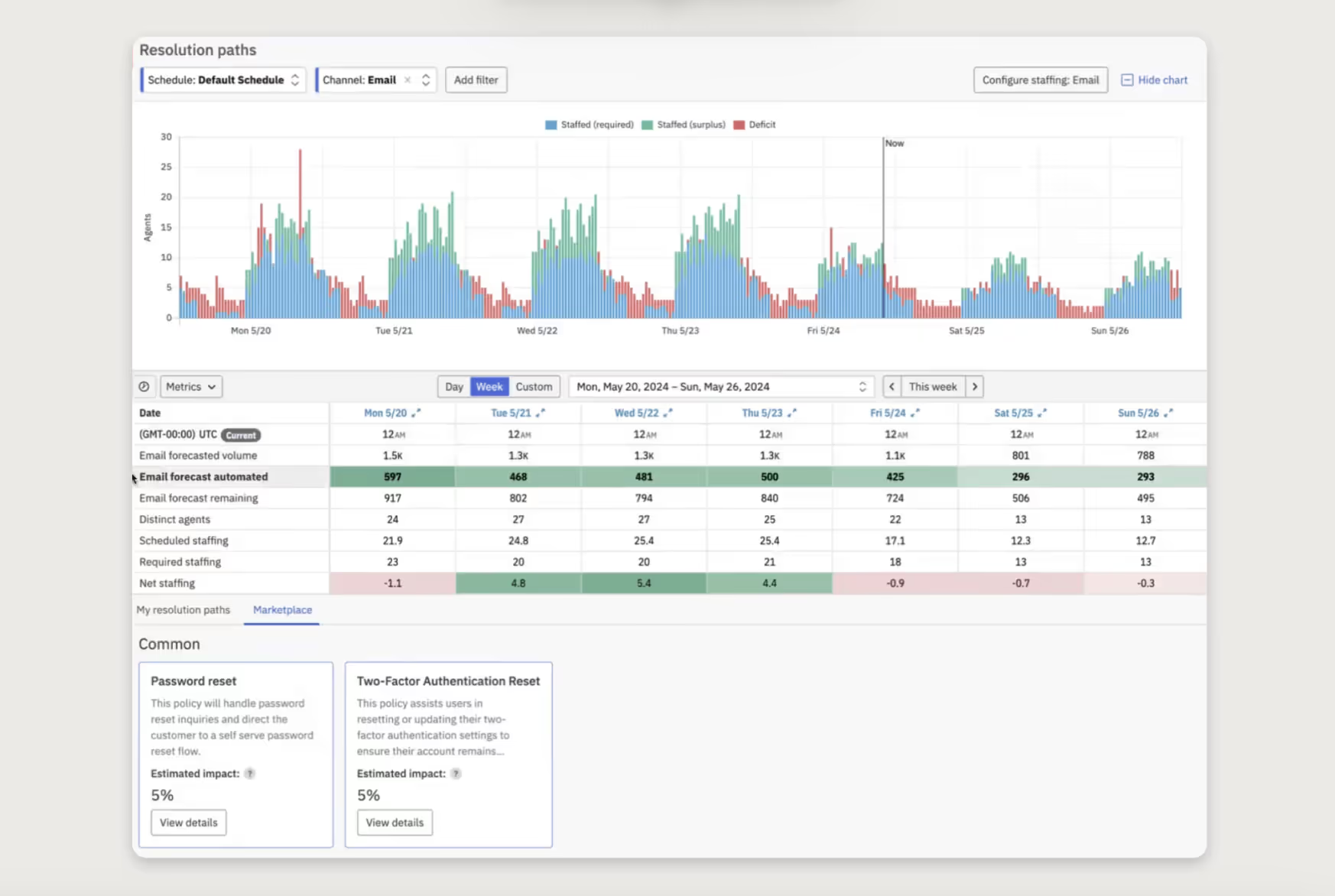
10. Quality assurance and training
What it is: While it’s usually not the first use case to come to mind, automation is playing an increasingly important role in quality assurance and agent training. These solutions automatically evaluate customer support interactions, provide insights into agent performance, and highlight coaching opportunities. Instead of manually reviewing a small sample of calls or chats, AI can analyze all of your interactions and call attention to meaningful improvement areas.
What it’s used for:
- Automating QA audits by scoring calls, chats, and emails for compliance, tone, and accuracy
- Identifying performance trends to highlight top agents and pinpoint coaching opportunities
- Providing real-time coaching with AI-driven feedback and assistance
- Accelerating agent training with personalized learning paths
Example: Your contact center implements AI-driven QA software that listens to all of your customer calls and flags potential compliance issues (such as an agent skipping a necessary disclosure). The system also provides real-time coaching by prompting agents with better phrasing when customers start to get frustrated.
Why it matters: Contact centers have notoriously high turnover rates, but adequate training can address that attrition and successfully onboard any new agents. While traditional QA processes can be tedious and limited, AI-driven QA looks at every customer conversation to pull out meaningful insights. This improves compliance, reduces errors, and upskills all of your agents even faster. That leads to a more consistent and higher-quality customer experience.
Automate your contact center operations with Assembled
Automation isn’t a magic bullet — but it’s not all hype or fluff either. When it’s used intentionally, it can inspire all sorts of meaningful benefits, like a better customer experience, improved efficiency, and even cost savings.
Ready to get started? Assembled has many of the features you need to adopt automation and keep pace with the current trends. With Assembled, you can:
Deliver seamless omnichannel support
With the Assembled Assist Omnichannel AI Agent, you can provide AI-powered, omnichannel support across chat, email, voice, Slack, and more. You’ll reduce your agent workload while also delivering consistent, top-notch support experiences.
✔️ Provide 24/7 support without adding headcount
✔️ Reduce ticket backlogs and prevent SLA breaches
✔️ Integrate AI seamlessly into your existing workflows
Support and empower your agents
Assembled Assist AI Copilot offers real-time replies, instant data lookups, and contextual guidance for your human agents. Instead of spending time searching for answers, your agents can focus on delivering fast, personalized, high-quality support.
✔️ Speed up your ticket handling with automated suggestions
✔️ Reduce repetitive tasks and after-call work
✔️ Ensure consistent, brand-aligned responses
Optimize your workflows
The AI Workflow Builder can automate even your complex customer service processes (like escalations and returns) without any coding.
✔️ Adapt workflows to your real-time demand
✔️ Ensure smooth escalations and case resolutions
✔️ Eliminate manual bottlenecks and tedious tasks
Build smarter schedules
Assembled’s scheduling functionality uses AI-powered forecasting to ensure your teams are staffed correctly at the right times, so you can avoid overstaffing during slow periods or scrambling during peak hours.
✔️ Predict staffing needs based on real-time data
✔️ Balance workloads to prevent agent burnout
✔️ Ensure SLA compliance by optimizing schedules
Turn insights into action
Much like any other change or improvement in your contact center, you need to keep an eye on AI to confirm it’s living up to your expectations. With Assembled Assist’s advanced reporting tools, you can track your AI accuracy, agent productivity, and customer experience trends in real time.
✔️ Gain full visibility into AI-driven resolutions and agent performance
✔️ Identify bottlenecks and areas for improvement
✔️ Make data-driven decisions to improve your service quality
Just the word “automation” can inspire a twinge of fear in your agents. But, if these contact center automation trends show us anything, it’s that automation isn’t about replacing your human agents — it’s about empowering them.
That’s where Assembled comes in. Take a closer look at how Assembled can transform your support team.

